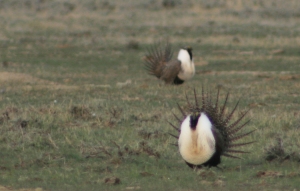USDA Report: Ranchers’ Conservation Efforts Positively Impact Sage Grouse
WASHINGTON –The United States Department of Agriculture this week issued a report showing that since 2010, USDA and its partners in the Sage Grouse Initiative have worked with private landowners to restore 4.4 million acres of habitat for sage-grouse while maintaining working landscapes across the West. USDA also announced today that, through the provisions of the 2014 Farm Bill, it will invest in new sage-grouse conservation work over the next four years.
The Sage Grouse initiative is a diverse partnership between ranchers, state and federal agencies, universities, non-profit groups, and private business led by Natural Resource Conservation Service.
“We’re working with ranchers who are taking proactive steps to improve habitat for sage-grouse while improving the sustainability of their agricultural operations,” Under Secretary for Natural Resources and Environment Robert Bonnie said. “Thanks to the interest from ranchers and support of our conservation partners, USDA’s Natural Resources Conservation Service is working to secure this species’ future while maintaining our vibrant western economies. Since 2010, we’ve worked with ranchers to conserve, restore, or maintain more than 4 million acres of habitat on private lands – an area twice the size Yellowstone National Park.
Sage Grouse are found in 11 states across the western United States and their habitat encompasses 186 million acres of both federal and private land. Public Lands Council President Brenda Richards said livestock grazing and wildlife habitat conservation are complimentary efforts.
“Ranchers are the original conservationists and the have been the best stewards of the land from the beginning,” said Richards, a rancher from Idaho. “I’m happy to see the hard work and dedication of ranchers is not only being recognized by USDA, but also encouraged to continue. With cooperation from stakeholders on the ground, the species and its habitat will be given the best possible chance to succeed.”
In the past five years, NRCS has invested $296.5 million to restore and conserve sage-grouse habitat, and has pledged to extend these efforts by approximately $200 million over four years through the conservation programs funded by the 2014 Farm Bill. Additionally, NRCS is piloting use of its Conservation Stewardship Program to broaden the impacts of SGI by targeting up to 275,000 acres to enhance sage-grouse habitat in 2015.
Through the SGI, conservation easements have increased across the range to 451,884 acres and have focused on eliminating the encroachment of conifer trees on grassland, which not only benefit the sage-grouse, but also improve the forage available on grazing lands. The overgrowth of trees and brush serve as fuel for wildfires and are a significant threat to the rangeland, said Richards.
“The biggest threat to any wildlife population is lack of open space. Ranchers ensure that rangelands remain intact and in good health,” Richards said. “We also know that for the sage grouse, wildfire is another large threat. Due to SGI’s cooperation with ranchers and other stakeholders to remove fuel loads from the range, the risk of wildfire is greatly reduced.”
###
PLC has represented livestock ranchers who use public lands since 1968, preserving the natural resources and unique heritage of the West. Ranchers who utilize public lands own nearly 120 million acres of the most productive private land and manage vast areas of public land, accounting for critical wildlife habitat and the nation’s natural resources. PLC works to maintain a stable business environment in which livestock producers can conserve the West and feed the nation and world.















